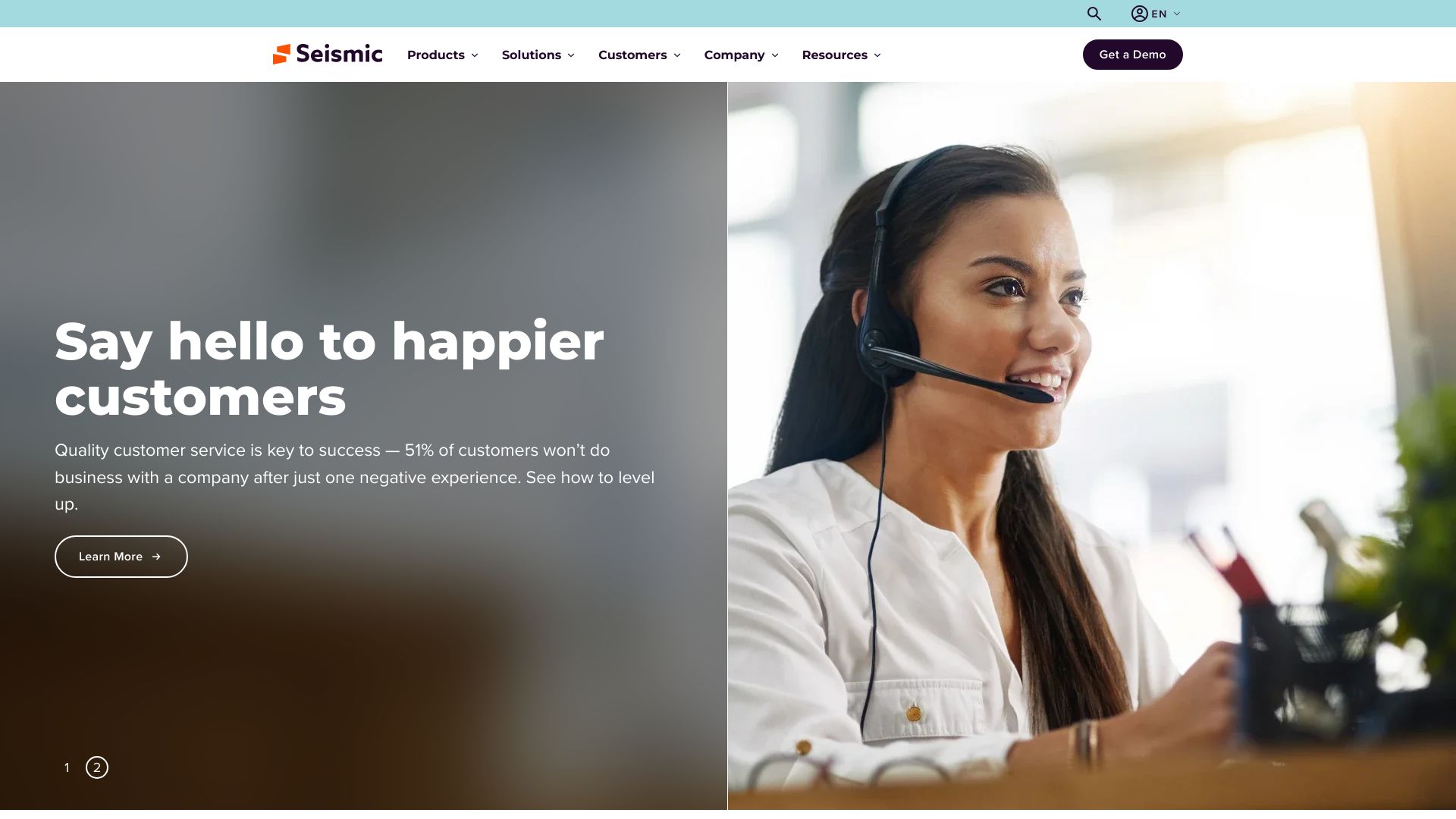- Home
- AI Customer Service
- Seismic

Seismic
Open Website-
Tool Introduction:Mood-based book tracker with smart recs, stats, tags, and challenges.
-
Inclusion Date:Oct 21, 2025
-
Social Media & Email:
Tool Information
What is Seismic AI
Seismic AI is an enterprise-grade, AI-powered sales enablement platform that unifies content management, learning and coaching, and buyer engagement in one place. By combining intelligent automation with predictive insights and personalized content delivery, it helps sales, marketing, and customer success teams engage buyers with precision and consistency. Teams centralize assets, automate playbooks, coach reps in the flow of work, and measure impact across the revenue cycle. The result is tighter messaging control, shorter sales cycles, and a data-driven enablement strategy that scales.
Seismic AI Key Features
- AI Content Recommendations: Surface the right collateral, playbooks, and talk tracks for each selling moment based on deal stage, persona, and historical performance.
- Sales Content Management: Centralize assets with governance, version control, approvals, and granular permissions to ensure teams use up-to-date materials.
- Learning & Coaching: Deliver microlearning, certifications, and role-based curricula; use AI to identify skill gaps and personalize coaching paths.
- Buyer Engagement: Create personalized spaces and content experiences to share assets, track buyer activity, and accelerate deal momentum.
- Content Automation: Generate data-driven proposals, one-pagers, and decks with dynamic fields to scale personalization without manual work.
- Strategy & Planning: Operationalize go-to-market playbooks and product launches, aligning content, training, and milestones across teams.
- Enablement Intelligence: Connect content usage and training completion to pipeline, win rates, and revenue influence with actionable analytics.
- Integrations: Embed enablement inside leading CRMs, email, and collaboration suites to streamline workflows and boost adoption.
Who Should Use Seismic AI
Seismic AI fits revenue organizations that need consistent messaging, governed content, and measurable enablement at scale. It is suited for sales reps and managers, revenue enablement leaders, product marketing, and customer success teams across mid-market and enterprise B2B. it's especially valuable for complex, multi-stakeholder deals, regulated industries requiring strict compliance, and teams running frequent product updates or multi-region go-to-market motions.
How to Use Seismic AI
- Define enablement goals and KPIs tied to pipeline, win rate, onboarding time, and content adoption.
- Connect core systems (CRM, CMS, collaboration, DAM) to sync metadata, contacts, and activity data.
- Import and organize content with taxonomies, expiration dates, approvals, and role-based permissions.
- Build playbooks and learning paths; assign courses and certifications by role, segment, and region.
- Configure AI recommendations and content automation rules for stages, personas, and industries.
- Launch seller workflows inside daily tools; share personalized buyer spaces and track engagement.
- Monitor enablement analytics; correlate content and training to deal velocity and conversion.
- Iterate playbooks and assets based on insights; retire low performers and scale proven materials.
Industry Use Cases
SaaS: Equip account executives with persona-based decks and AI-curated references, improving demo-to-close rates. Manufacturing: Generate localized spec sheets and proposals with dynamic data for distributors. Financial Services: Enforce compliance with governed content while tailoring messaging to client segments. Healthcare: Standardize clinical value stories and training for new product launches. Professional Services: Accelerate RFP responses with automated, branded documents.
Seismic AI Pricing
Seismic AI typically follows an enterprise, quote-based pricing model with modules for content management, learning, buyer engagement, and analytics. Costs often vary by number of users, feature bundles, and implementation scope. Demos and pilots are commonly used for evaluation; contact the vendor for a plan aligned to your team size and requirements.
Seismic AI Pros and Cons
Pros:
- Unified platform for content, training, and buyer engagement reduces tool sprawl.
- AI-driven recommendations and automation improve seller productivity and relevance.
- Robust governance ensures compliance, brand consistency, and version control.
- Rich analytics link enablement to pipeline influence and revenue outcomes.
- Deep workflow integrations drive adoption in sellers’ daily tools.
Cons:
- Enterprise breadth can introduce a learning curve and change management needs.
- Implementation and integrations may require dedicated admin resources.
- Investment level may be high for small teams with simple processes.
- Effectiveness depends on content hygiene and ongoing operational ownership.
Seismic AI FAQs
-
What does Seismic AI do?
It centralizes sales content, training, and buyer engagement, using AI to recommend assets, automate personalization, and measure impact on revenue.
-
Can it personalize content by persona or industry?
Yes. Rules and AI signals tailor decks, one-pagers, and proposals by stage, persona, and vertical while preserving brand and compliance.
-
How does Seismic AI measure ROI?
Enablement analytics connect content usage and learning completion to deal velocity, win rates, and influenced revenue with dashboards and reports.
-
Does it integrate with existing sales tools?
It integrates with popular CRMs, email, content repositories, and collaboration platforms to embed enablement in daily workflows.
-
Is Seismic AI suitable for smaller teams?
It is optimized for mid-market and enterprise needs; smaller teams can benefit but should weigh complexity and cost against requirements.




